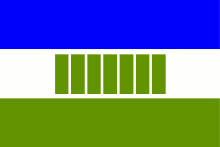Ovamboland
Ovamboland (also: Owamboland) is a region of Namibia. It is generally defined as the northernmost segment of the country which straddles the border between Namibia and Angola.[1] Ovamboland is the most densely populated region in Namibia.[1]


The term originally referred to the parts of northern Namibia inhabited by the Ovambo ethnic group, namely the area controlled by the traditional Ovambo kingdoms in pre-colonial and early colonial times, such as Ondonga, Ongandjera, and Oukwanyama.[1] Its endonym is Ovambo ~ Owambo.
History
German colonial period
Before the First World War, some infrastructure in the area was provided by local Finnish missionaries of the Finnish Missionary Society, who established Ovamboland as their first mission field in 1870, the first mission being at Omandongo.
During the First World War, South African troops conquered the German colony of South West Africa in 1915, and took control of Ovamboland in 1917, though it still lay outside the "police zone".
South African administration
Following the Odendaal Commission in the 1950s the South African government decided to apply the apartheid policy in South West Africa, which South Africa continued to rule in terms of a League of Nations mandate, and continued to do so after the mandate was revoked in 1968.
Ovamboland then became a bantustan called Owambo, intended by the apartheid government to be a self-governing "homeland" for the Ovambo people. It was set up in 1968 and self-government was granted in 1973.
Owambo was the setting of a protracted insurgency waged by the People's Liberation Army of Namibia (PLAN) during the South African Border War.[2]
Since independence of Namibia
Owambo, like other homelands in South West Africa, was abolished in May 1989 at the start of the transition to independence. The region is now commonly referred to as The North but the term Ovamboland is still in use. More than half of the entire population lives here on just 6% of the Namibian territory.
References
- Hayes, Patricia (2000). Hall, Catherine (ed.). Cultures of Empire: A Reader: Colonizers in Britain and the Empire in the Nineteenth and Twentieth Centuries. New York: Routledge Books. pp. 329–330. ISBN 978-0415929073.
- Stapleton, Timothy (2015). Warfare and Tracking in Africa, 1952–1990. Abingdon-on-Thames: Routledge Books. pp. 111–129. ISBN 978-1848935587.